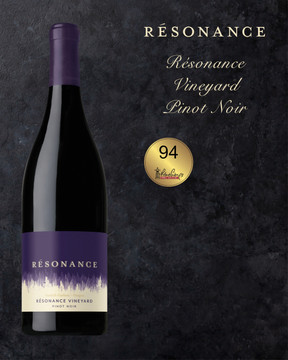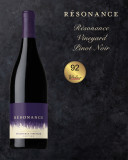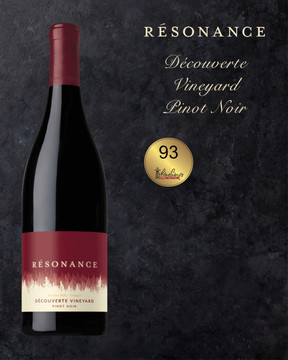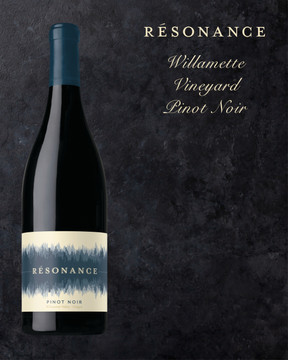
R̩esonance R̩sonance Vineyard Pinot Noir 2017.
Pale to medium ruby-purple, the 2017 Résonance Vineyard Pinot Noir features crushed blueberries, boysenberries and blackberries on the nose with notes of red berries, cinnamon, dried leaves and flowers. The medium-bodied palate is intense and firm with a grainy frame and good freshness, finishing long and fragrant. This will benefit from another year in bottle. About 1,500 cases were produced.
Résonance is the first winery outside of Burgundy from Maison Louis Jadot. The first vintage was 2013, and a new winery and tasting room were completed in time for the 2018 vintage. Longtime Jadot winemaker Jacques Ladière came out of retirement to oversee the project after visiting the already-established Résonance vineyard in Yamhill Carlton. Guillaume Large, who was born in Burgundy and previously worked at Jadot, moved to Oregon with his wife and young son to take charge of winemaking at Résonance.
The 19.5-acre Rèsonance vineyard, the winery’s signature estate vineyard, was originally planted, own-rooted, in 1981. It is organically and dry farmed and sits on a south-facing slope between 262–492 feet in elevation. Planted to Pommard, Dijon 777 and Wadenswil clones, the team is focused on massal selection for new plantings. Soils are mainly ancient silty basalt. The second estate vineyard, 15-acre Décourverte, is located in the Dundee Hills, planted mostly to Pinot Noir with 2.5 acres of Chardonnay. Soils are mostly Jory and clones include Pommard, Dijon 777 and Coury. A savvy color scheme indicates the origin of the wine in bottle: Résonance vineyard is bottled with a purple label, Décourverte with a red label and the Willamette Valley blend with a blue label. In 2016, the winery made about 8,000 cases, and they have plans to grow the label slowly. “We are increasing production bit by bit and have built the facility and winery in order to grow,” says Large. The new winery has room for a maximum of about 25,000 cases.
Wines are currently 100% destemmed, but Large and his team will continue to experiment as they learn about Oregon terroir. “We are still learning about this place and the potential of the terroir,” Large says. Half the fermentation tanks are open-top, while the other half are “horizontal tanks with the scoop to stir, like what we have in Burgundy,” says Large. One cooper is used, owned by Jadot, so that exact specifications for forest, grain, toast, etc. can be met. “Here, the wines are very expressive when young,” he says. “Not like Burgundy.” I asked what he thought about the aging potential for wines from both estate vineyards. “Here, I don’t know,” he says honestly. “We don’t have the limestone and the minerality of Burgundy but rather a different type of minerality at Résonance. I’m less sure about Décourverte. It’s so open today and full of expression. I’m not sure it will have the same ageability as Résonance, where I get the sensation of something vibrant and drinkable but with potential for the future. So, we don’t know, but we will learn. We have started a huge library. It’s a big effort, but it’s so important for us to be able to see the evolution of these wines over 10, 15, 20 years.”
I’ll be keenly interested to follow the evolution of this project. So far, investment from French wineries in Oregon has brought much needed innovation, expertise and experimentation to the region. Jadot’s latest projects bodes well for the future of quality wine in Oregon.
Erin Brooks - The Wine Adovocate Apr 23, 2020.
Pale to medium ruby-purple, the 2017 Résonance Vineyard Pinot Noir features crushed blueberries, boysenberries and blackberries on the nose with notes of red berries, cinnamon, dried leaves and flowers. The medium-bodied palate is intense and firm with a grainy frame and good freshness, finishing long and fragrant. This will benefit from another year in bottle. About 1,500 cases were produced.
Résonance is the first winery outside of Burgundy from Maison Louis Jadot. The first vintage was 2013, and a new winery and tasting room were completed in time for the 2018 vintage. Longtime Jadot winemaker Jacques Ladière came out of retirement to oversee the project after visiting the already-established Résonance vineyard in Yamhill Carlton. Guillaume Large, who was born in Burgundy and previously worked at Jadot, moved to Oregon with his wife and young son to take charge of winemaking at Résonance.
The 19.5-acre Rèsonance vineyard, the winery’s signature estate vineyard, was originally planted, own-rooted, in 1981. It is organically and dry farmed and sits on a south-facing slope between 262–492 feet in elevation. Planted to Pommard, Dijon 777 and Wadenswil clones, the team is focused on massal selection for new plantings. Soils are mainly ancient silty basalt. The second estate vineyard, 15-acre Décourverte, is located in the Dundee Hills, planted mostly to Pinot Noir with 2.5 acres of Chardonnay. Soils are mostly Jory and clones include Pommard, Dijon 777 and Coury. A savvy color scheme indicates the origin of the wine in bottle: Résonance vineyard is bottled with a purple label, Décourverte with a red label and the Willamette Valley blend with a blue label. In 2016, the winery made about 8,000 cases, and they have plans to grow the label slowly. “We are increasing production bit by bit and have built the facility and winery in order to grow,” says Large. The new winery has room for a maximum of about 25,000 cases.
Wines are currently 100% destemmed, but Large and his team will continue to experiment as they learn about Oregon terroir. “We are still learning about this place and the potential of the terroir,” Large says. Half the fermentation tanks are open-top, while the other half are “horizontal tanks with the scoop to stir, like what we have in Burgundy,” says Large. One cooper is used, owned by Jadot, so that exact specifications for forest, grain, toast, etc. can be met. “Here, the wines are very expressive when young,” he says. “Not like Burgundy.” I asked what he thought about the aging potential for wines from both estate vineyards. “Here, I don’t know,” he says honestly. “We don’t have the limestone and the minerality of Burgundy but rather a different type of minerality at Résonance. I’m less sure about Décourverte. It’s so open today and full of expression. I’m not sure it will have the same ageability as Résonance, where I get the sensation of something vibrant and drinkable but with potential for the future. So, we don’t know, but we will learn. We have started a huge library. It’s a big effort, but it’s so important for us to be able to see the evolution of these wines over 10, 15, 20 years.”
I’ll be keenly interested to follow the evolution of this project. So far, investment from French wineries in Oregon has brought much needed innovation, expertise and experimentation to the region. Jadot’s latest projects bodes well for the future of quality wine in Oregon.
Erin Brooks - The Wine Adovocate Apr 23, 2020.







